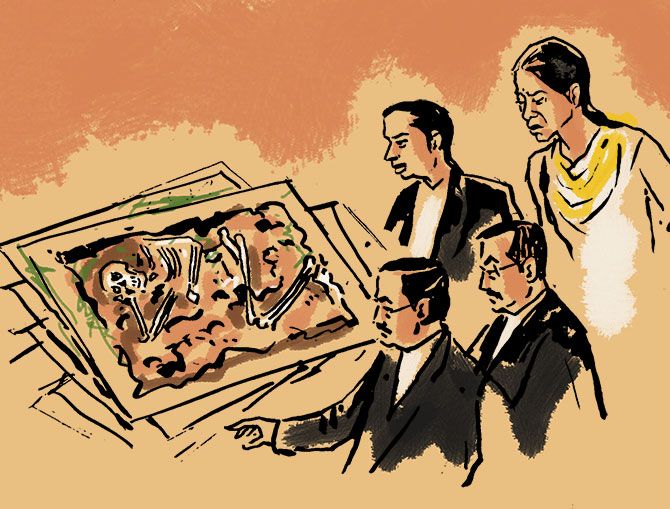The Sheena Bora murder case is one of the most notorious criminal proceedings in recent Indian legal history, capturing widespread attention due to its intricate web of deceit, betrayal, and homicide. This article endeavours to provide an in-depth legal analysis of the case, examining the relevant laws, judicial precedents, and forensic evidence that unfolded during the investigation and trial. Through a comprehensive exploration of the legal framework surrounding the case, we aim to unravel the complexities and shed light on the pursuit of justice in this high-profile criminal matter.
Background
Sheena Bora, a young woman with aspirations and dreams, met a tragic end in 2012 when she was allegedly murdered by her mother, Indrani Mukerjea, along with her former husband, Sanjeev Khanna, and Indrani’s driver, Shyamvar Rai.
On 24 April 2012, Sheena took a leave of absence and “sent in her written resignation”. On the same day, Rahul Mukerjea (Sheena’s step-brother who she was dating) received a breakup SMS from Sheena’s phone. Her mother, Indrani, said that Sheena had gone to the United States for higher studies and hence a missing First Information Report (FIR) was never filed.Sheena was never seen after 24 April 2012.
On Rahul’s insistence, Mumbai Police visited Indrani’s Worli residence where they were informed by the staff that Indrani was out of India. Upon her return, Indrani visited the Worli police station and informed the officers that Rahul was trying to stalk Sheena and that was why Sheena had moved to the US without informing him
The case initially baffled investigators, with Sheena’s disappearance remaining a mystery until startling revelations emerged years later, leading to the unravelling of a meticulously planned murder plot.

Legal Analysis
- Homicide
The crux of the Sheena Bora murder case revolves around the charge of homicide, as the prosecution alleges that Sheena was deliberately killed by the accused individuals. Under the Indian Penal Code (IPC), relevant provisions concerning homicide include:
a. Section 300: Murder b. Section 302: Punishment for murder c. Section 307: Attempt to murder
Section 300 of the IPC defines murder as the intentional causing of death with premeditated malice aforethought. The prosecution must establish beyond a reasonable doubt that the accused persons, namely Indrani Mukerjea, Sanjeev Khanna, and Shyamvar Rai, conspired and executed the murder of Sheena Bora with intent and deliberation.
Section 302 prescribes the punishment for murder, which may entail life imprisonment or the death penalty. If the prosecution successfully proves the guilt of the accused individuals under this provision, the court may impose the appropriate sentence based on the circumstances of the case and the severity of the offense.
Furthermore, Section 307 addresses attempts to commit murder, which may be relevant if there is evidence to suggest that the accused made unsuccessful attempts to kill Sheena Bora before ultimately succeeding in their nefarious plot.
- Conspiracy
The Sheena Bora murder case also implicates the accused individuals in a conspiracy to commit homicide, as evidenced by their purported collaboration and coordination in planning and executing the crime. The Indian legal system recognizes conspiracy as a distinct offence, governed by:
a. Section 120B: Punishment of criminal conspiracy
Section 120B of the IPC delineates criminal conspiracy as an agreement between two or more persons to commit an unlawful act or achieve an unlawful objective. In the context of the Sheena Bora murder case, the prosecution must establish that Indrani Mukerjea, Sanjeev Khanna, and Shyamvar Rai entered into a conspiracy to eliminate Sheena Bora, thereby rendering them liable for this additional charge.
Conspiracy charges carry significant legal consequences, with potential penalties including imprisonment and fines, depending on the gravity of the conspiracy and its ramifications.
- Forensic Evidence
Forensic evidence plays a pivotal role in corroborating the prosecution’s narrative and establishing the guilt of the accused beyond a reasonable doubt. In the Sheena Bora murder case, forensic examinations of the crime scene, including DNA analysis, forensic pathology, and ballistics, yielded critical insights into the circumstances surrounding Sheena’s death.
a. DNA Analysis: DNA samples collected from the crime scene, including bloodstains, hair follicles, and tissue samples, were subjected to rigorous analysis to ascertain their origin and link them to the victim and the accused individuals. DNA profiling techniques helped establish a conclusive connection between the accused and the crime, bolstering the prosecution’s case.
b. Forensic Pathology: Autopsy findings and forensic pathology reports provided crucial information regarding the cause and manner of Sheena Bora’s death. Examination of the victim’s remains, including skeletal injuries and traumatic injuries, aided forensic experts in reconstructing the sequence of events leading to her demise and identifying the mechanisms of injury inflicted upon her.
c. Ballistics Analysis: Analysis of ballistic evidence, including firearm residues, projectiles, and gunshot wounds, facilitated the determination of the weapon used in the commission of the crime. Ballistics experts meticulously examined the trajectories and patterns of gunshot injuries to ascertain the nature and extent of the assault on the victim, shedding light on the modus operandi of the perpetrators.
The convergence of forensic evidence corroborated the prosecution’s theory of the case, lending credence to their allegations of murder and conspiracy against the accused individuals.
- Legal Precedents
The Sheena Bora murder case evokes comparisons with precedent-setting legal decisions and landmark judgments involving similar factual and legal issues. Legal precedents serve as guiding principles for courts in interpreting and applying the law, thereby shaping the trajectory of criminal jurisprudence in India.
a. Precedent 1: State of Maharashtra v. Vijay Sharma (2015) – In this case, the accused was convicted of murder based on circumstantial evidence, highlighting the significance of corroborative evidence and the doctrine of “chain of circumstances” in establishing guilt beyond a reasonable doubt.
b. Precedent 2: State of Rajasthan v. Khetaram (2018) – The Supreme Court affirmed the conviction of the accused for conspiracy to commit murder, emphasizing the need for clear and cogent evidence to establish the existence of a conspiracy and the active participation of the accused therein.
c. Precedent 3: State of Uttar Pradesh v. Smt. Kusum and Ors. (2020) – The court upheld the admissibility of forensic evidence, including DNA analysis and forensic pathology reports, in establishing the culpability of the accused in a murder case, underscoring the importance of scientific expertise in criminal investigations.

Judgment
After a protracted legal battle marked by exhaustive trial proceedings and voluminous evidence, the court pronounced its verdict in the Sheena Bora murder case.
The accused individuals, Indrani Mukerjea, Sanjeev Khanna, and Shyamvar Rai, were found guilty of murder, conspiracy, and other related offences, with the court imposing stringent sentences commensurate with the gravity of their crimes.
The judgment underscored the court’s commitment to upholding the rule of law and ensuring justice for the victim, Sheena Bora, whose life was tragically cut short by the callous actions of those entrusted with her care and protection.
Conclusion
The Sheena Bora murder case stands as a poignant reminder of the complexities and challenges inherent in the pursuit of justice in cases of heinous crimes. Through meticulous investigation, diligent prosecution, and rigorous judicial scrutiny, the legal system strives to hold perpetrators accountable and provide closure to the families of the victims.
In conclusion, the legal analysis of the Sheena Bora murder case illuminates the intricate interplay of legal principles, forensic science, and judicial proceedings in the quest for truth and justice in a high-profile criminal matter.
Adv. Khanak Sharma


The staff always ensures confidentiality and privacy.
can i order cheap lisinopril online
A global name with a reputation for excellence.
Their staff is so knowledgeable and friendly.
can i get cipro pill
Their online prescription system is so efficient.
A true gem in the international pharmacy sector.
can you get cheap cipro pills
Their prices are unbeatable!
The team always keeps patient safety at the forefront.
can i get cheap cipro without prescription
They keep a broad spectrum of rare medications.
Their 24/7 support line is super helpful.
buy cheap clomid without rx
A universal solution for all pharmaceutical needs.